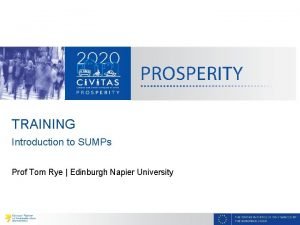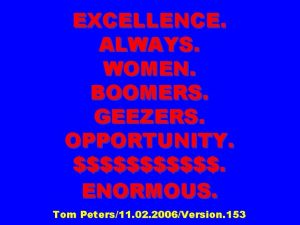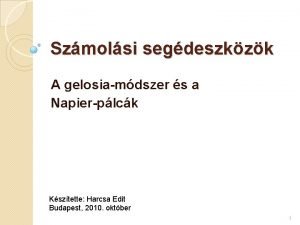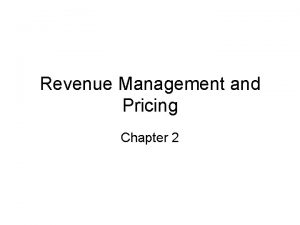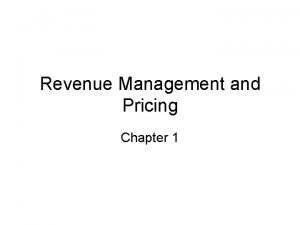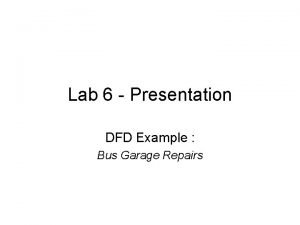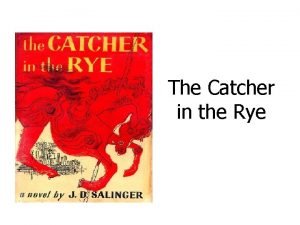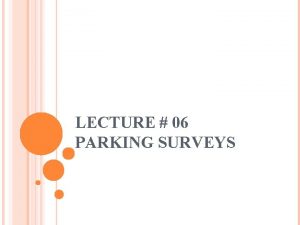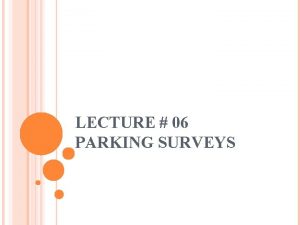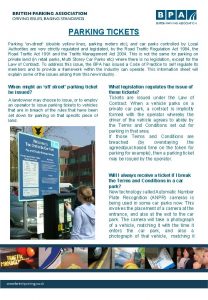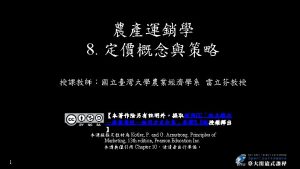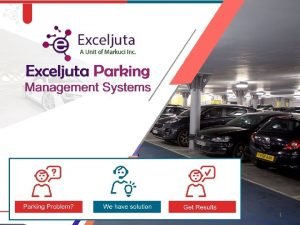PARKING Parking pricing and management Tom Rye Napier





























- Slides: 29

PARKING Parking pricing and management Tom Rye, Napier University, Edinburgh, UK t. rye@napier. ac. uk www. eu-portal. net

PARKING Parking policy • • • Problems – negative impacts Typical policy development Policy conflicts What do local authorities control? Regulating and enforcing on-street parking Off-street parking Effect of parking on economic vitality Park and ride Gaining acceptance for parking policy Some conclusions www. eu-portal. net

PARKING Structure of seminar At the end of today’s class you should have an understanding of: • • • Some definitions Parking – positive and negative impacts Typical policy development, and policy conflicts What do local authorities control? Regulating and enforcing on-street parking Off-street parking – types, costs, control, uses Effect of parking on economic vitality Park and ride Gaining public acceptance for parking policy How to develop parking policy and set up controlled parking zones Lecture and tutorials to get you working with the material www. eu-portal. net

PARKING Some definitions On-street Private non-residential (PNR) Pay and display parking meter Public off-street (can be in parking structures) www. eu-portal. net

PARKING Positive impacts of parking policy Has an impact on mode share Can support local economic development Major revenue earner Improves road safety Influences car ownership www. eu-portal. net

PARKING Negative impacts of parking Effect of on street parking (and parking search) on: • congestion, • road safety • environment • blocking bus lanes and stops; footways and crossings Off-street: • Construction costs and space used • Surface - € 3 k/space • Structure – € 15 -20 k/space • Underground - € 25 k/space upwards • Peak car journeys induced – esp. by PNR www. eu-portal. net

PARKING Parking management – what is it? Managing use and amounts of on- or off-street parking to bring about objectives such as: • Safety and pedestrian accessibility • Economic vitality – e. g. turnover of spaces • Reduced local congestion (search traffic) • Reduced visual impact • Revenue raising • Keeping particular user groups happy! • Reduced car use, increased public transport use – reduced general congestion Achieved through restrictions, rationing and pricing of existing spaces; and controls on new ones www. eu-portal. net

PARKING Effective parking management – what control is required? Public authorities might wish to have: Control of parking spaces • Most European countries municipalities control on-street parking • Wide variety of control of public off-street • No control of existing PNR (except Austria, UK, Sweden (tax)) • Some control of new PNR through building permits Control of enforcement and related matters • Most countries – police/judiciary have some role • Exceptions – NL, UK? Thus public management of parking – incomplete at best www. eu-portal. net

PARKING Some on-street parking prices Fee per hour (€) (2002) Vienna Brussels Paris Lyon Bremen Cologne Stuttgart Munich Dublin Amsterdam Maastricht Lisbon Madrid Barcelona Edinburgh Central London 0. 87 0. 50 1. 00 – 3. 00 1. 50 – 5. 00 0. 60 – 1. 50 1. 00 – 2. 00 0. 20 – 2. 00 – 2. 50 1. 00 – 1. 90 1. 60 - 2. 50 1. 40 0. 50 0. 60 – 1. 20 0. 90 – 1. 20 – 3. 00 7. 00 www. eu-portal. net

PARKING Parking’s effect on car and public transport use – 1 Clear relationship – some examples: www. eu-portal. net

PARKING Parking’s effect on car and public transport use - 2 Cities/regions where parking management known to have helped increase PT use and/or mode share: • Munich • Freiburg • Zurich • York • Brighton (UK) • Nottingham • Edinburgh • Strasbourg Empirical studies (Young, 1991, Paris; Topp, 1991, Munich) show mode shift in response to parking management Modelling e. g. Dasgupta et al (1994) shows parking much more effective than PT fares cuts as TDM tool www. eu-portal. net

PARKING Parking’s effect on car and public transport use - 3 (From COST 342 – latest European research) • Wiener Neustadt – new parking zone caused 25% of employees who had previously parked in area to switch to walking and cycling • Vienna Districts 5 -9 – new parking zone caused: • 30% decrease in traffic volumes • 30% of visitors and workers in the area who previously came by car switched mode • 7% visitors switched destination • (COST report does not state when these changes were introduced!) www. eu-portal. net

PARKING Parking’s effect on car and public transport use - Edinburgh All have limited onsite parking % non-car travellers 35% bank HQ 30% - business park 40% - hospital 2000 -2006 total bus use in Edinburgh up 25% www. eu-portal. net

PARKING Task For your town or city, what are the key problems and issues related to parking? Take 10 minutes working with your neighbour to think about this. Then we will discuss this, to look for commonalities – and differences. www. eu-portal. net

PARKING Policy conflicts Economic vitality Safety/ accessibility ? Demand/congestion management Revenue raising www. eu-portal. net

PARKING Typical development of a parking policy From COST 342 (especially relevant to on-street policy) • Stage 1 – no problems, • Stage 2 – as demand > supply, regulations introduced – NB what increases demand? Commuting; but also increased population as well as car ownership • Stage 3 - demand further increases – time limits introduced to favour short stay shoppers, visitors • Stage 4 – commuters pushed further out – conflict with residents – residents’ zones introduced • Stage 5 – more and more differentiation of parking tariffs • Stage 6 – park and ride. • Stage 7 – inclusion of parking in mobility management www. eu-portal. net

PARKING Off-street parking Public off-street vs private off-street (PNR) Major industry – who controls it? Prices – should be • < on-street? • Higher per hour for longer stays Who builds off-street public parking? Who pays for it? How much does it cost? Off-street parking for residents? • e. g. Lyon www. eu-portal. net

PARKING Parking and economic vitality Does more parking lead to a better economy? Does less parking lead to a worse economy? What role does parking play in: • Where shoppers choose to shop? • Where companies choose to locate? Are certain traders more dependent on parking than others? www. eu-portal. net

PARKING Park and ride 1 Why build park and ride? 1970 -1990 220% growth in P+R sites and 337% increase in P+R spaces in “Europe” (COST 342) Successful P+R needs: • • Frequent fast (cheap) public transport to centre Lack of parking in centre Easy road access to car park High quality secure facilities % of demand will come from trips previously made completely by PT Unofficial P+R? www. eu-portal. net

PARKING Park and ride 2 Effects of P+R on traffic (COST 342) • Vienna – P+R takes 12% of city centre-bound traffic • Chester – 20% • Madrid – 20, 000 users per day; Barcelona, 12, 000; Hanover, 10, 000. • Strasbourg – P+R key element in success of tram line. 43% of motorised trips now made by public transport. • Oxford, UK – 3 -9% reduction in city-centre bound traffic. www. eu-portal. net

PARKING Parking standards for new development = amount of parking provided with new buildings Catering for demand or controlling demand? Relating parking provision to public transport accessibility Catering for specific users e. g. disabled, parents, cyclists Should there be central government guidance on parking standards? Response of developers to constraints on parking provision www. eu-portal. net

PARKING PPG 13 Parking standards (UK) These are maximum standards • • • Food retail 1 space per 14 m 2 Non food retail 1 space per 20 m 2 Cinemas and conference facilities 1 space per 5 seats B 1 including offices 1 space per 30 m 2 = 1 space per 2 -3 staff Higher and further education - 1 space per 2 staff + 1 space per 15 students • Stadia 1 space per 15 seats • Residential (PPG 3) max 1. 5 spaces/house www. eu-portal. net

PARKING Parking standards elsewhere • Europe moving towards maximum standards… www. eu-portal. net

PARKING Parking and mobility management Mobility management – use of “soft” measures to get more out of transport system Parking – manages mobility Mobility management should include: • Parking/park and ride information • Parking management at large employers and at events • Links between parking pricing/payment and public transport pricing/payment www. eu-portal. net

PARKING Implementing workplace parking management When parking charging or rationing implemented as part of site-based mobility management, need to take into account: • Need for clear objectives and recognition of a problem • • Process of implementing charge Levels of charge, exemption from them Enforcement Employees’ contracts Administration Use of charge Overspill www. eu-portal. net

PARKING Gaining acceptance for parking policy Communication of changes and reasons for them Public know and understand the measures. Perceived benefit fees and other regulations related to size of problem. Alternative transport exists to a good standard. Revenue used fairly and transparently Parking regulations enforced consistently and fairly, Fines not excessive and related to seriousness of the offence www. eu-portal. net

PARKING Conclusions Parking - key determinant of mode choice Parking - key feature of urban transport policy Parking provision - should be controlled and related to accessibility by other modes? Link between parking and economic vitality – complex and unclear PNR can be addressed with political will Controlled zones can bring big local benefits Park and ride needs careful evaluation www. eu-portal. net

PARKING Task Read the summary of the conclusions from COST 342. Think – ready to discuss: • Are these conclusions relevant to your town and city? • Are there conclusions missing? • How would you go about implementing the recommendations? • What barriers would you face in implementing the recommendations? www. eu-portal. net

PARKING Task Work individually. You are responsible for the parking policy of your own town or city. For your city/town, you have to develop an outline of a parking strategy. You have 45 minutes to do this. In it, you must consider: • What are the most problematic issues? • What policies will you choose to implement, and why? • What will be the biggest barriers to implementing policy – and how might you try to overcome these? • Are there any problems/issues that you won’t be able to address effectively? • What further information do you need to be able to make effective decisions? www. eu-portal. net
 Tom rye
Tom rye Symbols in the devil and tom walker
Symbols in the devil and tom walker Parking pricing strategy
Parking pricing strategy Go 910
Go 910 Nz uniforms lower hutt
Nz uniforms lower hutt Napier kemikleri
Napier kemikleri Kay napier
Kay napier Peter napier
Peter napier Napier csontok
Napier csontok Bastoes de napier
Bastoes de napier Prima generatie de calculatoare
Prima generatie de calculatoare Jonh napier
Jonh napier Matematico john napier
Matematico john napier Whylogs
Whylogs John napier.
John napier. Logaritmo
Logaritmo Historia de logaritmos
Historia de logaritmos Role of pricing and revenue management in a supply chain
Role of pricing and revenue management in a supply chain Role of pricing and revenue management in a supply chain
Role of pricing and revenue management in a supply chain Pricing decision and cost management
Pricing decision and cost management Revenue management and pricing
Revenue management and pricing Revenue management and pricing
Revenue management and pricing Dfd parts
Dfd parts Umw eagle one
Umw eagle one Umw book store
Umw book store Pricing strategies in retail management
Pricing strategies in retail management Price management module
Price management module Catcher in the rye quotes with chapters
Catcher in the rye quotes with chapters Themes from catcher in the rye
Themes from catcher in the rye The catcher in the rye meaning
The catcher in the rye meaning
